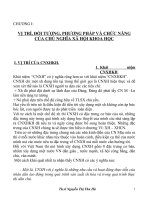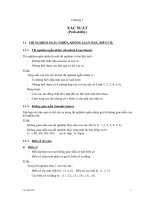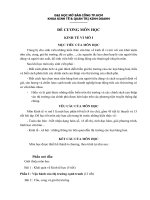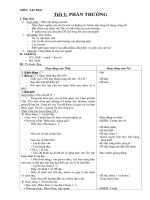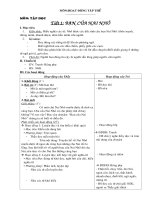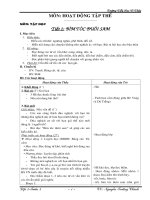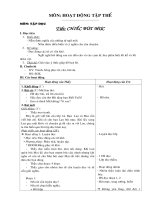- Trang chủ >>
- Đại cương >>
- Toán rời rạc
logistic computer i secince
Bạn đang xem bản rút gọn của tài liệu. Xem và tải ngay bản đầy đủ của tài liệu tại đây (2.17 MB, 440 trang )
LOGIC IN COMPUTER SCIENCE
Modelling and Reasoning about Systems
MICHAEL HUTH
Department of Computing
Imperial College London, United Kingdom
MARK RYAN
School of Computer Science
University of Birmingham, United Kingdom
CAMBRIDGE UNIVERSITY PRESS
Cambridge, New York, Melbourne, Madrid, Cape Town, Singapore, São Paulo
Cambridge University Press
The Edinburgh Building, Cambridge CB2 8RU, UK
Published in the United States of America by Cambridge University Press, New York
www.cambridge.org
Information on this title: www.cambridge.org/9780521543101
© Cambridge University Press 2004
This publication is in copyright. Subject to statutory exception and to the provision of
relevant collective licensing agreements, no reproduction of any part may take place
without the written permission of Cambridge University Press.
First published in print format 2004
ISBN-13
ISBN-10
978-0-511-26401-6 eBook (EBL)
0-511-26401-1 eBook (EBL)
ISBN-13
ISBN-10
978-0-521-54310-1 paperback
0-521-54310-X paperback
Cambridge University Press has no responsibility for the persistence or accuracy of urls
for external or third-party internet websites referred to in this publication, and does not
guarantee that any content on such websites is, or will remain, accurate or appropriate.
Contents
Foreword to the first edition
Preface to the second edition
Acknowledgements
1 Propositional logic
1.1 Declarative sentences
1.2 Natural deduction
1.2.1 Rules for natural deduction
1.2.2 Derived rules
1.2.3 Natural deduction in summary
1.2.4 Provable equivalence
1.2.5 An aside: proof by contradiction
1.3 Propositional logic as a formal language
1.4 Semantics of propositional logic
1.4.1 The meaning of logical connectives
1.4.2 Mathematical induction
1.4.3 Soundness of propositional logic
1.4.4 Completeness of propositional logic
1.5 Normal forms
1.5.1 Semantic equivalence, satisfiability and validity
1.5.2 Conjunctive normal forms and validity
1.5.3 Horn clauses and satisfiability
1.6 SAT solvers
1.6.1 A linear solver
1.6.2 A cubic solver
1.7 Exercises
1.8 Bibliographic notes
2 Predicate logic
2.1 The need for a richer language
v
page ix
xi
xiii
1
2
5
6
23
26
29
29
31
36
36
40
45
49
53
54
58
65
68
69
72
78
91
93
93
vi
Contents
2.2 Predicate logic as a formal language
2.2.1 Terms
2.2.2 Formulas
2.2.3 Free and bound variables
2.2.4 Substitution
2.3 Proof theory of predicate logic
2.3.1 Natural deduction rules
2.3.2 Quantifier equivalences
2.4 Semantics of predicate logic
2.4.1 Models
2.4.2 Semantic entailment
2.4.3 The semantics of equality
2.5 Undecidability of predicate logic
2.6 Expressiveness of predicate logic
2.6.1 Existential second-order logic
2.6.2 Universal second-order logic
2.7 Micromodels of software
2.7.1 State machines
2.7.2 Alma – re-visited
2.7.3 A software micromodel
2.8 Exercises
2.9 Bibliographic notes
3 Verification by model checking
3.1 Motivation for verification
3.2 Linear-time temporal logic
3.2.1 Syntax of LTL
3.2.2 Semantics of LTL
3.2.3 Practical patterns of specifications
3.2.4 Important equivalences between LTL formulas
3.2.5 Adequate sets of connectives for LTL
3.3 Model checking: systems, tools, properties
3.3.1 Example: mutual exclusion
3.3.2 The NuSMV model checker
3.3.3 Running NuSMV
3.3.4 Mutual exclusion revisited
3.3.5 The ferryman
3.3.6 The alternating bit protocol
3.4 Branching-time logic
3.4.1 Syntax of CTL
98
99
100
102
104
107
107
117
122
123
129
130
131
136
139
140
141
142
146
148
157
170
172
172
175
175
178
183
184
186
187
187
191
194
195
199
203
207
208
Contents
3.4.2 Semantics of CTL
3.4.3 Practical patterns of specifications
3.4.4 Important equivalences between CTL formulas
3.4.5 Adequate sets of CTL connectives
3.5 CTL* and the expressive powers of LTL and CTL
3.5.1 Boolean combinations of temporal formulas in CTL
3.5.2 Past operators in LTL
3.6 Model-checking algorithms
3.6.1 The CTL model-checking algorithm
3.6.2 CTL model checking with fairness
3.6.3 The LTL model-checking algorithm
3.7 The fixed-point characterisation of CTL
3.7.1 Monotone functions
3.7.2 The correctness of SATEG
3.7.3 The correctness of SATEU
3.8 Exercises
3.9 Bibliographic notes
4 Program verification
4.1 Why should we specify and verify code?
4.2 A framework for software verification
4.2.1 A core programming language
4.2.2 Hoare triples
4.2.3 Partial and total correctness
4.2.4 Program variables and logical variables
4.3 Proof calculus for partial correctness
4.3.1 Proof rules
4.3.2 Proof tableaux
4.3.3 A case study: minimal-sum section
4.4 Proof calculus for total correctness
4.5 Programming by contract
4.6 Exercises
4.7 Bibliographic notes
5 Modal logics and agents
5.1 Modes of truth
5.2 Basic modal logic
5.2.1 Syntax
5.2.2 Semantics
5.3 Logic engineering
5.3.1 The stock of valid formulas
vii
211
215
215
216
217
220
221
221
222
230
232
238
240
242
243
245
254
256
257
258
259
262
265
268
269
269
273
287
292
296
299
304
306
306
307
307
308
316
317
viii
Contents
5.3.2 Important properties of the accessibility relation
5.3.3 Correspondence theory
5.3.4 Some modal logics
5.4 Natural deduction
5.5 Reasoning about knowledge in a multi-agent system
5.5.1 Some examples
5.5.2 The modal logic KT45n
5.5.3 Natural deduction for KT45n
5.5.4 Formalising the examples
5.6 Exercises
5.7 Bibliographic notes
6 Binary decision diagrams
6.1 Representing boolean functions
6.1.1 Propositional formulas and truth tables
6.1.2 Binary decision diagrams
6.1.3 Ordered BDDs
6.2 Algorithms for reduced OBDDs
6.2.1 The algorithm reduce
6.2.2 The algorithm apply
6.2.3 The algorithm restrict
6.2.4 The algorithm exists
6.2.5 Assessment of OBDDs
6.3 Symbolic model checking
6.3.1 Representing subsets of the set of states
6.3.2 Representing the transition relation
6.3.3 Implementing the functions pre∃ and pre∀
6.3.4 Synthesising OBDDs
6.4 A relational mu-calculus
6.4.1 Syntax and semantics
6.4.2 Coding CTL models and specifications
6.5 Exercises
6.6 Bibliographic notes
Bibliography
Index
320
322
326
328
331
332
335
339
342
350
356
358
358
359
361
366
372
372
373
377
377
380
382
383
385
387
387
390
390
393
398
413
414
418
Foreword to the first edition
by
Edmund M. Clarke
FORE Systems Professor of Computer Science
Carnegie Mellon University
Pittsburgh, PA
Formal methods have finally come of age! Specification languages, theorem
provers, and model checkers are beginning to be used routinely in industry.
Mathematical logic is basic to all of these techniques. Until now textbooks
on logic for computer scientists have not kept pace with the development
of tools for hardware and software specification and verification. For example, in spite of the success of model checking in verifying sequential circuit
designs and communication protocols, until now I did not know of a single text, suitable for undergraduate and beginning graduate students, that
attempts to explain how this technique works. As a result, this material is
rarely taught to computer scientists and electrical engineers who will need to
use it as part of their jobs in the near future. Instead, engineers avoid using
formal methods in situations where the methods would be of genuine benefit
or complain that the concepts and notation used by the tools are complicated and unnatural. This is unfortunate since the underlying mathematics
is generally quite simple, certainly no more difficult than the concepts from
mathematical analysis that every calculus student is expected to learn.
Logic in Computer Science by Huth and Ryan is an exceptional book.
I was amazed when I looked through it for the first time. In addition to
propositional and predicate logic, it has a particularly thorough treatment
of temporal logic and model checking. In fact, the book is quite remarkable
in how much of this material it is able to cover: linear and branching time
temporal logic, explicit state model checking, fairness, the basic fixpoint
ix
x
Foreword to the first edition
theorems for computation tree logic (CTL), even binary decision diagrams
and symbolic model checking. Moreover, this material is presented at a level
that is accessible to undergraduate and beginning graduate students. Numerous problems and examples are provided to help students master the
material in the book. Since both Huth and Ryan are active researchers in
logics of programs and program verification, they write with considerable
authority.
In summary, the material in this book is up-to-date, practical, and elegantly presented. The book is a wonderful example of what a modern text
on logic for computer science should be like. I recommend it to the reader
with greatest enthusiasm and predict that the book will be an enormous
success.
(This foreword is re-printed in the second edition with its author’s permission.)
Preface to the second edition
Our motivation for (re)writing this book
One of the leitmotifs of writing the first edition of our book was the observation that most logics used in the design, specification and verification of
computer systems fundamentally deal with a satisfaction relation
M
φ
where M is some sort of situation or model of a system, and φ is a specification, a formula of that logic, expressing what should be true in situation
M. At the heart of this set-up is that one can often specify and implement
algorithms for computing . We developed this theme for propositional,
first-order, temporal, modal, and program logics. Based on the encouraging feedback received from five continents we are pleased to hereby present
the second edition of this text which means to preserve and improve on the
original intent of the first edition.
What’s new and what’s gone
Chapter 1 now discusses the design, correctness, and complexity of a SAT
solver (a marking algorithm similar to St˚
almarck’s method [SS90]) for full
propositional logic.
Chapter 2 now contains basic results from model theory (Compactness
Theorem and LăowenheimSkolem Theorem); a section on the transitive closure and the expressiveness of existential and universal second-order logic;
and a section on the use of the object modelling language Alloy and its analyser for specifying and exploring under-specified first-order logic models with
respect to properties written in first-order logic with transitive closure. The
Alloy language is executable which makes such exploration interactive and
formal.
xi
xii
Preface to the second edition
Chapter 3 has been completely restructured. It now begins with a discussion of linear-time temporal logic; features the open-source NuSMV modelchecking tool throughout; and includes a discussion on planning problems,
more material on the expressiveness of temporal logics, and new modelling
examples.
Chapter 4 contains more material on total correctness proofs and a new
section on the programming-by-contract paradigm of verifying program correctness.
Chapters 5 and 6 have also been revised, with many small alterations and
corrections.
The interdependence of chapters and prerequisites
The book requires that students know the basics of elementary arithmetic
and naive set theoretic concepts and notation. The core material of Chapter 1 (everything except Sections 1.4.3 to 1.6.2) is essential for all of the
chapters that follow. Other than that, only Chapter 6 depends on Chapter 3
and a basic understanding of the static scoping rules covered in Chapter 2 –
although one may easily cover Sections 6.1 and 6.2 without having done
Chapter 3 at all. Roughly, the interdependence diagram of chapters is
1
2
3
4
5
6
WWW page
This book is supported by a Web page, which contains a list of errata;
text files for all the program code; ancillary technical material and links;
all the figures; an interactive tutor based on multiple-choice questions;
and details of how instructors can obtain the solutions to exercises in
this book which are marked with a ∗. The URL for the book’s page
is www.cs.bham.ac.uk/research/lics/. See also www.cambridge.org/
052154310x
Acknowledgements
Many people have, directly or indirectly, assisted us in writing this book.
David Schmidt kindly provided serveral exercises for Chapter 4. Krysia
Broda has pointed out some typographical errors and she and the other
authors of [BEKV94] have allowed us to use some exercises from that book.
We have also borrowed exercises or examples from [Hod77] and [FHMV95].
Susan Eisenbach provided a first description of the Package Dependency
System that we model in Alloy in Chapter 2. Daniel Jackson make very
helpful comments on versions of that section. Zena Matilde Ariola, Josh
Hodas, Jan Komorowski, Sergey Kotov, Scott A. Smolka and Steve Vickers
have corresponded with us about this text; their comments are appreciated.
Matt Dwyer and John Hatcliff made useful comments on drafts of Chapter 3. Kevin Lucas provided insightful comments on the content of Chapter
6, and notified us of numerous typographical errors in several drafts of the
book. Achim Jung read several chapters and gave useful feedback.
Additionally, a number of people read and provided useful comments on
several chapters, including Moti Ben-Ari, Graham Clark, Christian Haack,
Anthony Hook, Roberto Segala, Alan Sexton and Allen Stoughton. Numerous students at Kansas State University and the University of Birmingham
have given us feedback of various kinds, which has influenced our choice and
presentation of the topics. We acknowledge Paul Taylor’s LATEX package for
proof boxes. About half a dozen anonymous referees made critical, but constructive, comments which helped to improve this text in various ways. In
spite of these contributions, there may still be errors in the book, and we
alone must take responsibility for those.
Added for second edition
Many people have helped improve this text by pointing out typos and
making other useful comments after the publication date. Among them,
xiii
xiv
Acknowledgements
we mention Wolfgang Ahrendt, Yasuhiro Ajiro, Torben Amtoft, Stephan
Andrei, Bernhard Beckert, Jonathan Brown, James Caldwell, Ruchira Datta,
Amy Felty, Dimitar Guelev, Hirotsugu Kakugawa, Kamran Kashef, Markus
Kră
otzsch, Jagun Kwon, Ranko Lazic, David Makinson, Alexander Miczo,
Aart Middeldorp, Robert Morelli, Prakash Panangaden, Aileen Paraguya,
Frank Pfenning, Shekhar Pradhan, Koichi Takahashi, Kazunori Ueda,
Hiroshi Watanabe, Fuzhi Wang and Reinhard Wilhelm.
1
Propositional logic
The aim of logic in computer science is to develop languages to model the
situations we encounter as computer science professionals, in such a way
that we can reason about them formally. Reasoning about situations means
constructing arguments about them; we want to do this formally, so that
the arguments are valid and can be defended rigorously, or executed on a
machine.
Consider the following argument:
Example 1.1 If the train arrives late and there are no taxis at the station,
then John is late for his meeting. John is not late for his meeting. The train
did arrive late. Therefore, there were taxis at the station.
Intuitively, the argument is valid, since if we put the first sentence and
the third sentence together, they tell us that if there are no taxis, then John
will be late. The second sentence tells us that he was not late, so it must be
the case that there were taxis.
Much of this book will be concerned with arguments that have this structure, namely, that consist of a number of sentences followed by the word
‘therefore’ and then another sentence. The argument is valid if the sentence
after the ‘therefore’ logically follows from the sentences before it. Exactly
what we mean by ‘follows from’ is the subject of this chapter and the next
one.
Consider another example:
Example 1.2 If it is raining and Jane does not have her umbrella with her,
then she will get wet. Jane is not wet. It is raining. Therefore, Jane has her
umbrella with her.
This is also a valid argument. Closer examination reveals that it actually
has the same structure as the argument of the previous example! All we have
1
2
1 Propositional logic
done is substituted some sentence fragments for others:
Example 1.1
the train is late
there are taxis at the station
John is late for his meeting
Example 1.2
it is raining
Jane has her umbrella with her
Jane gets wet.
The argument in each example could be stated without talking about trains
and rain, as follows:
If p and not q, then r. Not r. p. Therefore, q.
In developing logics, we are not concerned with what the sentences really
mean, but only in their logical structure. Of course, when we apply such
reasoning, as done above, such meaning will be of great interest.
1.1 Declarative sentences
In order to make arguments rigorous, we need to develop a language in which
we can express sentences in such a way that brings out their logical structure.
The language we begin with is the language of propositional logic. It is based
on propositions, or declarative sentences which one can, in principle, argue
as being true or false. Examples of declarative sentences are:
(1)
(2)
(3)
(4)
(5)
(6)
The sum of the numbers 3 and 5 equals 8.
Jane reacted violently to Jack’s accusations.
Every even natural number >2 is the sum of two prime numbers.
All Martians like pepperoni on their pizza.
Albert Camus etait un ecrivain franácais.
Die Wă
urde des Menschen ist unantastbar.
These sentences are all declarative, because they are in principle capable of
being declared ‘true’, or ‘false’. Sentence (1) can be tested by appealing to
basic facts about arithmetic (and by tacitly assuming an Arabic, decimal
representation of natural numbers). Sentence (2) is a bit more problematic.
In order to give it a truth value, we need to know who Jane and Jack are
and perhaps to have a reliable account from someone who witnessed the
situation described. In principle, e.g., if we had been at the scene, we feel
that we would have been able to detect Jane’s violent reaction, provided
that it indeed occurred in that way. Sentence (3), known as Goldbach’s
conjecture, seems straightforward on the face of it. Clearly, a fact about
all even numbers >2 is either true or false. But to this day nobody knows
whether sentence (3) expresses a truth or not. It is even not clear whether
this could be shown by some finite means, even if it were true. However, in
1.1 Declarative sentences
3
this text we will be content with sentences as soon as they can, in principle,
attain some truth value regardless of whether this truth value reflects the
actual state of affairs suggested by the sentence in question. Sentence (4)
seems a bit silly, although we could say that if Martians exist and eat pizza,
then all of them will either like pepperoni on it or not. (We have to introduce
predicate logic in Chapter 2 to see that this sentence is also declarative if no
Martians exist; it is then true.) Again, for the purposes of this text sentence
(4) will do. Et alors, qu’est-ce qu’on pense des phrases (5) et (6)? Sentences
(5) and (6) are fine if you happen to read French and German a bit. Thus,
declarative statements can be made in any natural, or artificial, language.
The kind of sentences we won’t consider here are non-declarative ones,
like
r Could you please pass me the salt?
r Ready, steady, go!
r May fortune come your way.
Primarily, we are interested in precise declarative sentences, or statements
about the behaviour of computer systems, or programs. Not only do we
want to specify such statements but we also want to check whether a given
program, or system, fulfils a specification at hand. Thus, we need to develop
a calculus of reasoning which allows us to draw conclusions from given assumptions, like initialised variables, which are reliable in the sense that they
preserve truth: if all our assumptions are true, then our conclusion ought to
be true as well. A much more difficult question is whether, given any true
property of a computer program, we can find an argument in our calculus
that has this property as its conclusion. The declarative sentence (3) above
might illuminate the problematic aspect of such questions in the context of
number theory.
The logics we intend to design are symbolic in nature. We translate a certain sufficiently large subset of all English declarative sentences into strings
of symbols. This gives us a compressed but still complete encoding of declarative sentences and allows us to concentrate on the mere mechanics of our
argumentation. This is important since specifications of systems or software
are sequences of such declarative sentences. It further opens up the possibility of automatic manipulation of such specifications, a job that computers
just love to do1 . Our strategy is to consider certain declarative sentences as
1
There is a certain, slightly bitter, circularity in such endeavours: in proving that a certain
computer program P satisfies a given property, we might let some other computer program Q try
to find a proof that P satisfies the property; but who guarantees us that Q satisfies the property
of producing only correct proofs? We seem to run into an infinite regress.
4
1 Propositional logic
being atomic, or indecomposable, like the sentence
‘The number 5 is even.’
We assign certain distinct symbols p, q, r, . . ., or sometimes p1 , p2 , p3 , . . . to
each of these atomic sentences and we can then code up more complex
sentences in a compositional way. For example, given the atomic sentences
p: ‘I won the lottery last week.’
q: ‘I purchased a lottery ticket.’
r: ‘I won last week’s sweepstakes.’
we can form more complex sentences according to the rules below:
¬: The negation of p is denoted by ¬p and expresses ‘I did not win the lottery
last week,’ or equivalently ‘It is not true that I won the lottery last week.’
∨: Given p and r we may wish to state that at least one of them is true: ‘I won the
lottery last week, or I won last week’s sweepstakes;’ we denote this declarative
sentence by p ∨ r and call it the disjunction of p and r2 .
∧: Dually, the formula p ∧ r denotes the rather fortunate conjunction of p and r:
‘Last week I won the lottery and the sweepstakes.’
→: Last, but definitely not least, the sentence ‘If I won the lottery last week,
then I purchased a lottery ticket.’ expresses an implication between p and q,
suggesting that q is a logical consequence of p. We write p → q for that3 . We
call p the assumption of p → q and q its conclusion.
Of course, we are entitled to use these rules of constructing propositions
repeatedly. For example, we are now in a position to form the proposition
p ∧ q → ¬r ∨ q
which means that ‘if p and q then not r or q’. You might have noticed a
potential ambiguity in this reading. One could have argued that this sentence
has the structure ‘p is the case and if q then . . . ’ A computer would require
the insertion of brackets, as in
(p ∧ q) → ((¬r) ∨ q)
2
3
Its meaning should not be confused with the often implicit meaning of or in natural language
discourse as either . . . or. In this text or always means at least one of them and should not be
confounded with exclusive or which states that exactly one of the two statements holds.
The natural language meaning of ‘if . . . then . . . ’ often implicitly assumes a causal role of
the assumption somehow enabling its conclusion. The logical meaning of implication is a bit
different, though, in the sense that it states the preservation of truth which might happen
without any causal relationship. For example, ‘If all birds can fly, then Bob Dole was never
president of the United States of America.’ is a true statement, but there is no known causal
connection between the flying skills of penguins and effective campaigning.
1.2 Natural deduction
5
to disambiguate this assertion. However, we humans get annoyed by a proliferation of such brackets which is why we adopt certain conventions about
the binding priorities of these symbols.
Convention 1.3 ¬ binds more tightly than ∨ and ∧, and the latter two
bind more tightly than →. Implication → is right-associative: expressions of
the form p → q → r denote p → (q → r).
1.2 Natural deduction
How do we go about constructing a calculus for reasoning about propositions, so that we can establish the validity of Examples 1.1 and 1.2? Clearly,
we would like to have a set of rules each of which allows us to draw a conclusion given a certain arrangement of premises.
In natural deduction, we have such a collection of proof rules. They allow us to infer formulas from other formulas. By applying these rules in
succession, we may infer a conclusion from a set of premises.
Let’s see how this works. Suppose we have a set of formulas4 φ1 , φ2 ,
φ3 , . . . , φn , which we will call premises, and another formula, ψ, which we
will call a conclusion. By applying proof rules to the premises, we hope
to get some more formulas, and by applying more proof rules to those, to
eventually obtain the conclusion. This intention we denote by
φ1 , φ2 , . . . , φn
ψ.
This expression is called a sequent; it is valid if a proof for it can be found.
The sequent for Examples 1.1 and 1.2 is p ∧ ¬q → r, ¬r, p q. Constructing such a proof is a creative exercise, a bit like programming. It is not
necessarily obvious which rules to apply, and in what order, to obtain the
desired conclusion. Additionally, our proof rules should be carefully chosen;
otherwise, we might be able to ‘prove’ invalid patterns of argumentation. For
4
It is traditional in logic to use Greek letters. Lower-case letters are used to stand for formulas
and upper-case letters are used for sets of formulas. Here are some of the more commonly used
Greek letters, together with their pronunciation:
Lower-case
φ
phi
ψ
psi
χ
chi
η
eta
α
alpha
β
beta
γ
gamma
Upper-case
Φ
Phi
Ψ
Psi
Γ
Gamma
∆
Delta
6
1 Propositional logic
example, we expect that we won’t be able to show the sequent p, q p ∧ ¬q.
For example, if p stands for ‘Gold is a metal.’ and q for ‘Silver is a metal,’
then knowing these two facts should not allow us to infer that ‘Gold is a
metal whereas silver isn’t.’
Let’s now look at our proof rules. We present about fifteen of them in
total; we will go through them in turn and then summarise at the end of
this section.
1.2.1 Rules for natural deduction
The rules for conjunction Our first rule is called the rule for conjunction (∧): and-introduction. It allows us to conclude φ ∧ ψ, given that we
have already concluded φ and ψ separately. We write this rule as
φ
ψ
φ∧ψ
∧i.
Above the line are the two premises of the rule. Below the line goes the
conclusion. (It might not yet be the final conclusion of our argument;
we might have to apply more rules to get there.) To the right of the line,
we write the name of the rule; ∧i is read ‘and-introduction’. Notice that we
have introduced a ∧ (in the conclusion) where there was none before (in the
premises).
For each of the connectives, there is one or more rules to introduce it and
one or more rules to eliminate it. The rules for and-elimination are these
two:
φ∧ψ
φ
∧e1
φ∧ψ
ψ
∧e2 .
(1.1)
The rule ∧e1 says: if you have a proof of φ ∧ ψ, then by applying this rule
you can get a proof of φ. The rule ∧e2 says the same thing, but allows
you to conclude ψ instead. Observe the dependences of these rules: in the
first rule of (1.1), the conclusion φ has to match the first conjunct of the
premise, whereas the exact nature of the second conjunct ψ is irrelevant.
In the second rule it is just the other way around: the conclusion ψ has to
match the second conjunct ψ and φ can be any formula. It is important
to engage in this kind of pattern matching before the application of proof
rules.
Example 1.4 Let’s use these rules to prove that p ∧ q, r |− q ∧ r is valid.
We start by writing down the premises; then we leave a gap and write the
1.2 Natural deduction
7
conclusion:
p∧q
r
q∧r
The task of constructing the proof is to fill the gap between the premises
and the conclusion by applying a suitable sequence of proof rules. In this
case, we apply ∧e2 to the first premise, giving us q. Then we apply ∧i to this
q and to the second premise, r, giving us q ∧ r. That’s it! We also usually
number all the lines, and write in the justification for each line, producing
this:
1
p∧q
premise
2
r
premise
3
q
∧e2 1
4
q∧r
∧i 3, 2
Demonstrate to yourself that you’ve understood this by trying to show on
your own that (p ∧ q) ∧ r, s ∧ t |− q ∧ s is valid. Notice that the φ and ψ can
be instantiated not just to atomic sentences, like p and q in the example we
just gave, but also to compound sentences. Thus, from (p ∧ q) ∧ r we can
deduce p ∧ q by applying ∧e1 , instantiating φ to p ∧ q and ψ to r.
If we applied these proof rules literally, then the proof above would actually be a tree with root q ∧ r and leaves p ∧ q and r, like this:
p∧q
q
∧e2
q∧r
r
∧i
However, we flattened this tree into a linear presentation which necessitates
the use of pointers as seen in lines 3 and 4 above. These pointers allow
us to recreate the actual proof tree. Throughout this text, we will use the
flattened version of presenting proofs. That way you have to concentrate only
on finding a proof, not on how to fit a growing tree onto a sheet of paper.
If a sequent is valid, there may be many different ways of proving it. So if
you compare your solution to these exercises with those of others, they need
not coincide. The important thing to realise, though, is that any putative
proof can be checked for correctness by checking each individual line, starting
at the top, for the valid application of its proof rule.
1 Propositional logic
8
The rules of double negation Intuitively, there is no difference between a formula φ and its double negation ¬¬φ, which expresses no more
and nothing less than φ itself. The sentence
‘It is not true that it does not rain.’
is just a more contrived way of saying
‘It rains.’
Conversely, knowing ‘It rains,’ we are free to state this fact in this more
complicated manner if we wish. Thus, we obtain rules of elimination and
introduction for double negation:
¬¬φ
φ
¬¬e
φ
¬¬φ
¬¬i.
(There are rules for single negation on its own, too, which we will see later.)
Example 1.5 The proof of the sequent p, ¬¬(q ∧ r)
most of the proof rules discussed so far:
1
p
2
¬¬(q ∧ r) premise
3
¬¬p
¬¬i 1
4
q∧r
¬¬e 2
5
r
∧e2 4
6
¬¬p ∧ r
∧i 3, 5
¬¬p ∧ r below uses
premise
Example 1.6 We now prove the sequent (p ∧ q) ∧ r, s ∧ t |− q ∧ s which
you were invited to prove by yourself in the last section. Please compare
the proof below with your solution:
1
(p ∧ q) ∧ r
premise
2
s∧t
premise
3
p∧q
∧e1 1
4
q
∧e2 3
5
s
∧e1 2
6
q∧s
∧i 4, 5
1.2 Natural deduction
9
The rule for eliminating implication There is one rule to introduce
→ and one to eliminate it. The latter is one of the best known rules of
propositional logic and is often referred to by its Latin name modus ponens.
We will usually call it by its modern name, implies-elimination (sometimes
also referred to as arrow-elimination). This rule states that, given φ and
knowing that φ implies ψ, we may rightfully conclude ψ. In our calculus, we
write this as
φ
φ→ψ
ψ
→e.
Let us justify this rule by spelling out instances of some declarative sentences p and q. Suppose that
p : It rained.
p → q : If it rained, then the street is wet.
so q is just ‘The street is wet.’ Now, if we know that it rained and if we
know that the street is wet in the case that it rained, then we may combine
these two pieces of information to conclude that the street is indeed wet.
Thus, the justification of the →e rule is a mere application of common sense.
Another example from programming is:
p : The value of the program’s input is an integer.
p → q : If the program’s input is an integer, then the program outputs
a boolean.
Again, we may put all this together to conclude that our program outputs
a boolean value if supplied with an integer input. However, it is important
to realise that the presence of p is absolutely essential for the inference
to happen. For example, our program might well satisfy p → q, but if it
doesn’t satisfy p – e.g. if its input is a surname – then we will not be able to
derive q.
As we saw before, the formal parameters φ and the ψ for →e can be
instantiated to any sentence, including compound ones:
1
¬p ∧ q
premise
2
¬p ∧ q → r ∨ ¬p
premise
3
r ∨ ¬p
→e 2, 1
1 Propositional logic
10
Of course, we may use any of these rules as often as we wish. For example,
given p, p → q and p → (q → r), we may infer r:
1
p → (q → r) premise
2
p→q
premise
3
p
premise
4
q→r
→e 1, 3
5
q
→e 2, 3
6
r
→e 4, 5
Before turning to implies-introduction, let’s look at a hybrid rule which
has the Latin name modus tollens. It is like the →e rule in that it eliminates
an implication. Suppose that p → q and ¬q are the case. Then, if p holds
we can use →e to conclude that q holds. Thus, we then have that q and ¬q
hold, which is impossible. Therefore, we may infer that p must be false. But
this can only mean that ¬p is true. We summarise this reasoning into the
rule modus tollens, or MT for short:5
φ → ψ ¬ψ
¬φ
MT.
Again, let us see an example of this rule in the natural language setting:
‘If Abraham Lincoln was Ethiopian, then he was African. Abraham
Lincoln was not African; therefore he was not Ethiopian.’
Example 1.7 In the following proof of
p → (q → r), p, ¬r
¬q
we use several of the rules introduced so far:
5
1
p → (q → r) premise
2
p
premise
3
¬r
premise
4
q→r
→e 1, 2
5
¬q
MT 4, 3
We will be able to derive this rule from other ones later on, but we introduce it here because it
allows us already to do some pretty slick proofs. You may think of this rule as one on a higher
level insofar as it does not mention the lower-level rules upon which it depends.
1.2 Natural deduction
11
Examples 1.8 Here are two example proofs which combine the rule MT
with either ¬¬e or ¬¬i:
1
¬p → q
premise
2
¬q
premise
3
¬¬p
MT 1, 2
4
p
¬¬e 3
proves that the sequent ¬p → q, ¬q
p is valid; and
1
p → ¬q
premise
2
q
premise
3
¬¬q
¬¬i 2
4
¬p
MT 1, 3
shows the validity of the sequent p → ¬q, q
¬p.
Note that the order of applying double negation rules and MT is different
in these examples; this order is driven by the structure of the particular
sequent whose validity one is trying to show.
The rule implies introduction The rule MT made it possible for us to
show that p → q, ¬q ¬p is valid. But the validity of the sequent p → q
¬q → ¬p seems just as plausible. That sequent is, in a certain sense, saying
the same thing. Yet, so far we have no rule which builds implications that
do not already occur as premises in our proofs. The mechanics of such a rule
are more involved than what we have seen so far. So let us proceed with
care. Let us suppose that p → q is the case. If we temporarily assume that
¬q holds, we can use MT to infer ¬p. Thus, assuming p → q we can show
that ¬q implies ¬p; but the latter we express symbolically as ¬q → ¬p. To
summarise, we have found an argumentation for p → q ¬q → ¬p:
1
p→q
premise
2
¬q
assumption
3
¬p
MT 1, 2
4
¬q → ¬p
→i 2−3
The box in this proof serves to demarcate the scope of the temporary assumption ¬q. What we are saying is: let’s make the assumption of ¬q. To
12
1 Propositional logic
do this, we open a box and put ¬q at the top. Then we continue applying
other rules as normal, for example to obtain ¬p. But this still depends on
the assumption of ¬q, so it goes inside the box. Finally, we are ready to
apply →i. It allows us to conclude ¬q → ¬p, but that conclusion no longer
depends on the assumption ¬q. Compare this with saying that ‘If you are
French, then you are European.’ The truth of this sentence does not depend
on whether anybody is French or not. Therefore, we write the conclusion
¬q → ¬p outside the box.
This works also as one would expect if we think of p → q as a type of a
procedure. For example, p could say that the procedure expects an integer
value x as input and q might say that the procedure returns a boolean value
y as output. The validity of p → q amounts now to an assume-guarantee
assertion: if the input is an integer, then the output is a boolean. This
assertion can be true about a procedure while that same procedure could
compute strange things or crash in the case that the input is not an integer. Showing p → q using the rule →i is now called type checking, an
important topic in the construction of compilers for typed programming
languages.
We thus formulate the rule →i as follows:
φ
..
.
ψ
φ→ψ
→i.
It says: in order to prove φ → ψ, make a temporary assumption of φ and then
prove ψ. In your proof of ψ, you can use φ and any of the other formulas
such as premises and provisional conclusions that you have made so far.
Proofs may nest boxes or open new boxes after old ones have been closed.
There are rules about which formulas can be used at which points in the
proof. Generally, we can only use a formula φ in a proof at a given point if
that formula occurs prior to that point and if no box which encloses that
occurrence of φ has been closed already.
The line immediately following a closed box has to match the pattern
of the conclusion of the rule that uses the box. For implies-introduction,
this means that we have to continue after the box with φ → ψ, where φ
was the first and ψ the last formula of that box. We will encounter two
more proof rules involving proof boxes and they will require similar pattern
matching.
